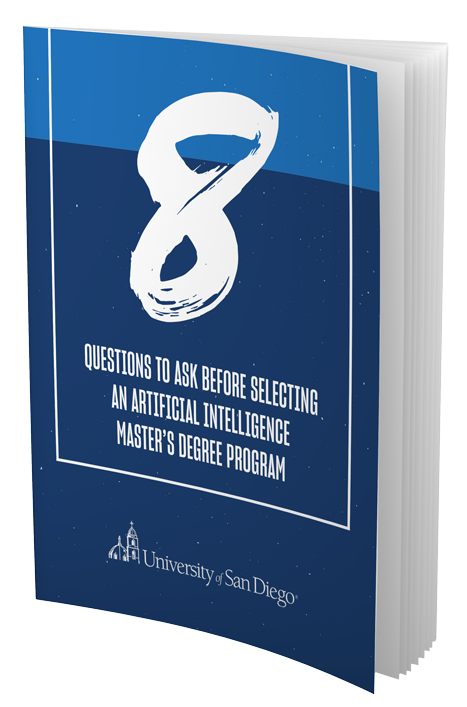No matter where you turn, everyone’s talking about artificial intelligence (AI).
That’s because AI tools such as ChatGPT, Claude and Perplexity are now a part of everyday life. Pew Research Center reports that the share of Americans who have used ChatGPT is now double what it was in summer 2023 and that one in five U.S. workers now use AI in their job. And those are just the tools people are aware of: According to Gallup, nearly all Americans use products that include AI features, but nearly two-thirds (64%) don’t realize it.
With ubiquity comes opportunity. Today’s computer science students can help shape the future of AI and become ethical tech leaders — while capitalizing on a lucrative job market — by becoming AI trainers.
Let’s talk about how.
What Is an AI Trainer?
An AI trainer is exactly what they sound like: a person responsible for teaching chatbots, virtual assistants, virtual agents and other AI-powered tools to interact in a human-like way. At a more technical level, AI trainers carefully review training datasets for potential biases and inaccuracies before feeding them into machine learning models to ensure the fidelity of those models’ responses.
Here’s a more detailed breakdown of the different roles and responsibilities an AI trainer may fulfill:
- Curating, cleaning and organizing datasets
- Labeling data accurately according to project-specific guidelines
- Performing quality checks on annotated data
- Designing labeling schemes or taxonomies to help structure data
- Setting up and running model training pipelines
- Monitoring training runs, logs and performance metrics
- Providing feedback or fine-tuning data to improve model accuracy
- Implementing active learning loops
- Testing AI models on new or unseen data
- Designing evaluation benchmarks and test scenarios
- Analyzing model outputs for errors, bias and edge-case behavior
- Providing feedback to reinforce learning systems
- Writing and refining prompts or instructions
- Evaluating model responses for clarity, correctness and usefulness
- Reviewing AI outputs to ensure they meet ethical, factual and stylistic standards
- Recording observations, issues and results from training and evaluation sessions
- Creating internal documentation and annotation guides
- Reporting data quality problems, inconsistencies or model drift to engineers
Titles for AI trainers vary by organization; some employers refer to them as chatbot trainers, AI raters, AI annotators, large language model (LLM) trainers, conversation designers and so on. AI trainers often work closely with data scientists, machine learning engineers and linguists to improve workflows, making them a dedicated part of their company’s innovation teams.
Education for the AI Trainer
As an AI trainer, you will be responsible for developing and maintaining AI models, which includes understanding the data they rely on to operate and communicating with other IT experts and stakeholders.
It’s helpful to have a background in technology, mathematics, computer science or engineering, as well as any industry-specific subjects you may be interested in pursuing. More lucrative AI leadership roles require at least a master’s degree to take on the added responsibilities of management and advanced projects.
The University of San Diego offers one of the country’s only 100% online master’s degree programs in AI. Courses take a total of 20 months to complete and are updated in real time to keep pace with this rapidly changing industry. Students have access to faculty with standout experience in the field, all from the comfort of their own homes.
Curriculum for USD’s Master of Science in Applied Artificial Intelligence (MS-AAI) program focuses on technical strategies and skills to prepare those who are new to real-world applications and professionals seeking to deepen their skill set. The program culminates with a Capstone experience that hones students’ abilities and applies them to the workplace. USD MS-AAI graduates report an average salary of $116,510 and have gone on to work for major companies, including Apple, Google, Amazon and more.
15 Skills You Need to Succeed as an AI Trainer
To be a successful AI trainer, you need a combination of hard and soft skills that showcase your interests and talents. Hard skills demonstrate the technical expertise required to develop and maintain AI models, while soft skills enable effective communication with stakeholders, as well as the creativity and passion to keep pace with the latest technologies.
Consider these sought-after hard skills when applying for AI trainer roles:
- Data analysis: Inspecting and closely examining data to pull meaningful insights, identify patterns and make improvements
- Machine learning: Developing algorithms and statistical models, in essence enabling computers to learn from data and use it to make predictions
- Programming: Writing code using programming languages such as Python, JavaScript and SQL to perform specific tasks
- Data visualization: Creating graphs, charts and models to convey information to coworkers, including those who may not be familiar with the technical side of AI
- Cloud computing: Liaising between the consumer and the cloud system in which data is stored and secured
- Algorithm optimization: Refining algorithms to improve efficiency with techniques such as code refactoring, using more efficient data structures and applying mathematical insights
- Data literacy: Understanding, interpreting and using data effectively to inform decisions, ensuring quality and reliability in training data sets
- Quality assurance: Verifying that datasets and models meet required standards of accuracy, performance and ethical considerations before deployment
- Labeling and annotation: Assigning accurate and consistent labels or annotations to data, such as images, text or audio, in line with project guidelines for model training
- Prompt and policy tuning: Fine-tuning AI models with carefully crafted prompts and policies to guide model behavior and improve alignment with desired outputs
While they aren’t requisite skills, a working knowledge of application programming interfaces (APIs) and annotation platforms is a bonus, since many AI training environments rely on API-based integrations and platform-specific configurations to function..
Soft skills remain as important as ever in the age of AI. The following are highly valued in an AI trainer role:
- Communication: Effectively communicating complex ideas and technical concepts with team members, stakeholders and non-technical audiences to ensure alignment and clarity across all parties
- Problem-solving: Addressing challenges and roadblocks that arise during the development, training and deployment of AI systems, while identifying creative solutions to maintain progress
- Passion for continuous improvement: Staying up-to-date with the latest advancements, tools and methodologies in the AI field
- Organization: Managing multiple tasks and responsibilities, prioritizing projects effectively and coordinating with various team members to meet deadlines and deliver high-quality results in parallel
- Privacy and ethics: Understanding and applying ethical principles privacy laws to ensure responsible AI development, preventing bias, discrimination and misuse of data
AI Trainer Salary & Job Outlook
Job outlook and earning potential are promising for computer and information research scientists, which includes AI trainers. According to the U.S. Bureau of Labor Statistics, employment is projected to grow by 20% from 2024 to 2034, much faster than the average for all occupations, which is 3%.
Workers looking to enter the occupation typically need a master’s degree to do so. And while advanced education comes with a price tag, it often pays for itself through higher earning potential. The median annual salary in 2024 was reported at $140,910, with the lowest 10% earning less than $80,670 and the highest 10% earning more than $232,120.
Looking more specifically at data for AI trainers, Glassdoor reports a range of $63,000 to $116,000 per year, with a median salary of $84,000. It’s important to note, though, that salaries will range by industry, location, experience level and specialization.
For example, an AI trainer with entry-level experience working for a nonprofit can expect to make between $51,000 to $86,000 per year, with a median salary of $66,000. While this is still a respectable starting salary, compare it to an AI trainer with 15+ years of experience in the pharmaceutical and biotech industry, who can command anywhere from $116,000 to $200,000 per year, with a median salary of $151,000.
An AI trainer based in San Francisco, CA with one to three years of experience could make $77,000 and $91,000 per year — considerably more than an AI trainer with the same level of experience based in North Brunswick, NJ ($58,000–$67,000).
* All job listings and figures sourced in October 2025. Please note that these listings and figures may fluctuate over time as new salaries are entered. For the most up-to-date information, we recommend checking the original sources directly.
Where AI Trainers Work
Companies around the world already have a real need for qualified AI trainers, and demand is only growing. From insurance and manufacturing to real estate and retail, there are AI training opportunities available across all industries, though Glassdoor lists information technology, healthcare and personal consumer services as the highest paying.
Here’s a glimpse of the industries AI trainers work in and their responsibilities respective to each one:
| Technology | – Train AI models using datasets to improve accuracy and performance – Work closely with data scientists and engineers to refine AI systems for efficiency – Fine-tune algorithms – Optimize AI models for specific tasks |
| Healthcare | – Implement AI models to analyze medical images such as X-rays, MRIs and CT scans – Create and refine algorithms to detect patterns in patient data to diagnose potential diseases or predictive treatment |
| Customer Service | – Leverage chatbots and virtual assistants to respond to customer service inquiries 24/7 with natural-sounding language – Refine models based on user interaction to enhance customer experiences |
| Financial Services | – Train models to conduct fraud detection and risk assessment – Assist banking customers with account functions such as deposits, withdrawals and transfers |
| Education | – Enhance learning by personalizing lesson plans – Program AI to assist teachers with grading assignments quickly and accurately – Power interactive games that teach academic skills such as reading and math |
How to Become an AI Trainer in 5 Steps
Demand for skilled AI trainers has never been higher. Interested in pursuing this career? Here are five steps to get you on the right path:
Step 1: Learn the basics.
The first step to becoming an AI model trainer is to build a strong foundation in the fundamentals of AI and machine learning. Key areas to focus on are:
- Mathematics: Familiarize yourself with linear algebra, calculus and probability, all of which are foundational to understanding machine learning algorithms.
- Programming: While it isn’t a requirement, familiarity with Python — the primary language used in AI development — is strongly encouraged. Familiarity with libraries such as TensorFlow, PyTorch and scikit-learn will also be beneficial.
- Data science: Learn how to manipulate and analyze data, as AI trainers work with large datasets to help models learn effectively.
You don’t need to become an expert overnight, but having a strong grasp of these areas will help you succeed in the next steps.
Step 2: Practice on a real dataset.
It’s time to start applying your knowledge to real-world scenarios by working with actual datasets. There are numerous publicly available datasets from sites such as Kaggle, UCI Machine Learning Repository and government data portals. These datasets provide a sandbox for you to practice data cleaning, labeling and modeling skills. Practicing with real datasets will give you a hands-on understanding of the challenges AI trainers face in the field, while also sharpening your technical abilities.
Step 3: Build a portfolio.
A portfolio is your personal showcase of the work you’ve done, and it’s an essential asset when applying for AI model training roles. As you practice on real datasets, be sure to document your projects, highlighting your ability to clean, annotate and preprocess data, as well as any results or improvements you were able to achieve. This will demonstrate your practical experience and make you a more attractive candidate to employers.
When building your portfolio, be sure to include:
- Completed projects: Provide clear descriptions of the problems you worked on, your approach and the final results.
- Code and scripts: Share your coding work so potential employers can review your programming skills.
- Data visualizations: Showcase how you analyzed and presented data to draw meaningful conclusions.
Step 4: Apply to entry-level positions.
Next, it’s time to take the leap and apply for entry-level AI trainer roles. These positions might be labeled as chatbot trainers, AI rates, AI annotators, LLM trainers or similar. Don’t be discouraged if these positions seem basic at first; entry-level jobs are your opportunity to gain real-world experience in AI training.
In addition to applying for job postings, consider reaching out to companies that align with your career goals and offering to intern or volunteer. This can be a great way to get your foot in the door and gain exposure to the inner workings of AI development teams. Networking on LinkedIn, attending AI conferences and joining AI-related communities can also help you build connections and discover job opportunities.
Step 5: Level up.
The final step of your journey is to continually progress in your career. A great way to earn higher level roles in AI training and adjacent fields is to pursue an advanced degree.
The Master of Science in Applied Artificial Intelligence at the University of San Diego goes beyond the basics of data preparation and model training to explore advanced topics such as neural networks and deep learning, generative AI, applied computer vision for AI and applied AI ethics. Program graduates will be equipped to develop technologies within organizations for the deployment of AI-based systems and software and to be effective leaders and managers in an increasingly AI-based world.
Earning a master’s degree will not only strengthen your resume but also signal to employers that you’re serious about mastering the discipline and ready to take on more advanced challenges. Whether your goal is to become a senior AI trainer, machine learning engineer or a research specialist, the MS-AAI is a strategic investment in your future and the technologies that will define it.
Frequently Asked Questions
What is an AI trainer?
An AI trainer is responsible for teaching artificial intelligence systems, such as chatbots, virtual assistants and other AI-powered tools, to communicate and perform tasks in a human-like manner. At a more technical level, AI trainers review and prepare datasets for machine learning models, ensuring accuracy and fairness so that models can deliver reliable, high-quality responses.
What does an AI trainer do?
AI trainers:
- Curate, clean and label datasets
- Perform quality assurance checks
- Design labeling systems to structure data effectively
- Test AI models on new data and analyze outputs for errors or bias
- Fine-tune models to improve accuracy and performance
Many AI model trainers work closely with data scientists, machine learning engineers and linguists to enhance workflows and develop smarter, more ethical AI systems.
What’s the difference between an AI trainer and a prompt engineer?
Both AI trainers and prompt engineers play an important role in optimizing AI systems, but where an AI trainer specializes in preparing data and training models, a prompt engineer focuses on refining interactions to get the best outputs from an already trained model. Prompt engineers will often experiment with the phrasing, structure and context of prompts to get AI systems to behave in the desired way, with the ultimate goal of improving how AI understands or responds to questions or tasks.
How do I become an AI trainer?
To become an AI trainer:
- Start by learning the basics of artificial intelligence, machine learning and data science.
- Practice working with real datasets to develop your technical and analytical skills.
- Build a portfolio that highlights your projects and experience.
- Apply for entry-level roles, such as data annotator or chatbot trainer, to gain hands-on experience.
- Consider pursuing an advanced degree, such as the Master of Science in Applied Artificial Intelligence at the University of San Diego, to deepen your expertise and prepare for leadership or specialized positions.
How much do AI trainers make?
According to 2025 Glassdoor data, AI trainers typically earn between $63,000 and $116,000 per year, with a median salary of $84,000. Salaries vary based on industry, experience and location. For example, experienced AI trainers in high-demand sectors such as information technology, healthcare and personal consumer services can earn well into six figures. Entry-level trainers may start between $50,000 and $70,000 annually, with significant growth potential as they gain experience and pursue advanced education.




